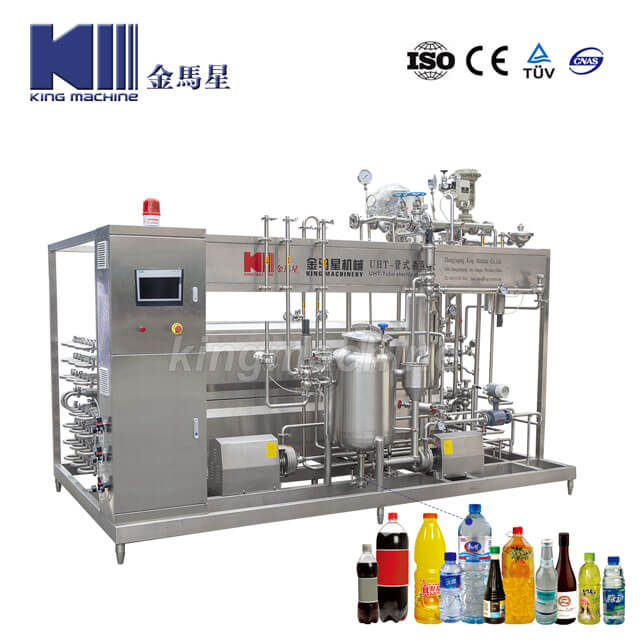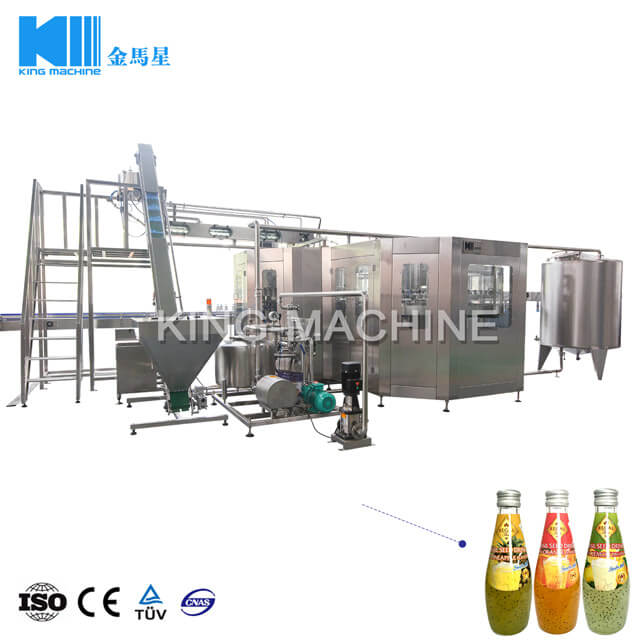The juice industry is booming worldwide, with consumers increasingly seeking fresh, healthy, and convenient beverage options. Small juice factories, producing between 10,000 and 50,000 bottles per hour (BPH), face unique challenges. They must maintain high product quality while optimizing efficiency, managing costs, and ensuring compliance with strict food safety standards. Setting up a production line tailored to these needs is critical for business success.
A well-planned juice production line can reduce downtime, improve consistency, minimize waste, and support future growth. This article explores the best setup for small juice factories, covering essential equipment, design considerations, and features that ensure smooth, efficient, and hygienic operation.

Before investing in machinery, factory owners should carefully assess several factors:
Production Capacity and Growth: Small juice factories producing 10,000–50,000 BPH need machinery that can scale efficiently without requiring a complete redesign.
Beverage Type: The line should be tailored for the type of juice—still juice, pulp-containing juice, smoothie, or mixed beverages. Some types require specialized extraction or blending equipment.
Bottle Type and Size: PET bottles, glass bottles, or aseptic cartons affect filling, capping, and labeling choices.
Factory Space: Available floor space influences line layout, workflow, and expansion possibilities.
Budget and ROI: Equipment costs, installation, and operating expenses should align with projected revenue and profitability.
Regulatory Compliance: Small juice factories must meet food safety standards, including HACCP, GMP, ISO, or local regulations.
By addressing these factors first, manufacturers can design a line that meets current needs while remaining flexible for future growth.
2.Essential Components of a Small Juice Production Line
A complete juice production line integrates multiple stages, from fruit reception to packaging. For small factories, it is essential to select equipment that balances capacity, efficiency, and ease of maintenance.
Fruit Receiving and Sorting
The production process begins with raw material reception. Fruits should be sorted for quality, washed thoroughly, and inspected for defects. High-quality sorting ensures that only the best ingredients enter production, preventing spoilage and maintaining flavor consistency. For certain fruits, peeling, crushing, or pulping equipment may also be needed.
Juice Extraction and Pulp Processing
Juice extraction methods vary depending on fruit type and desired final product. Common approaches include:
Cold-press extraction: Retains more nutrients and flavor but operates at a lower throughput.
Centrifugal extraction: Faster and suitable for high-volume lines but may introduce foam.
Enzyme-assisted extraction: Breaks down fruit fibers for higher yield and smoother consistency.
After extraction, pulp separation and clarification may be necessary. Juice blending ensures uniform flavor, Brix, and acidity levels across batches.
Pasteurization or Sterilization
Pasteurization or sterilization is vital for extending shelf life and ensuring safety. Small juice factories typically use:
HTST (High-Temperature Short-Time): Quickly heats juice to kill microorganisms while preserving taste.
UHT (Ultra-High Temperature): Enables longer shelf life, particularly for aseptic packaging.
Proper temperature control and monitoring are crucial during this stage, as under-processing can lead to spoilage, while over-processing may degrade flavor and nutrients.
Juice Mixing and Flavoring
Once pasteurized, juices may require blending with other ingredients, sugar, vitamins, or flavors. Homogenization is often applied to achieve smooth consistency, especially for pulp-containing or dairy-infused beverages. Quality control checks—Brix (sugar content), pH, and acidity—ensure the final product meets specifications.
Filling and Packaging
For small factories, filling machines must balance speed with accuracy. Common filling methods include:
Gravity filling: Ideal for still juices with low viscosity.
Piston filling: Suitable for pulpy or thick juices.
Volumetric filling: Delivers precise volumes for uniform bottles.
Following filling, bottles are capped, sealed, labeled, and, if necessary, coded for traceability. Packaging may include shrink-wrapping, boxing, or palletizing, depending on distribution needs.
Juice Bottling Line Integration
A complete small juice production line integrates filling, capping, labeling, and packaging via conveyors and star wheels. Synchronization of all equipment ensures smooth operation and minimizes bottlenecks, maintaining consistent output.

3.Hygienic and Efficient Design Features
Hygiene is a top priority in juice production, as contamination can compromise safety and shelf life. Small factories benefit from machines designed for food safety, easy cleaning, and long-term reliability.
Food-Grade Stainless Steel: Most machines use SS304 or SS316, offering corrosion resistance and durability under cleaning chemicals.
Smooth Surfaces and Rounded Corners: Prevent bacteria buildup and simplify inspection and maintenance.
Closed Processing Systems: For sensitive juices, equipment may include enclosed designs, positive-pressure airflow, or HEPA filtration to minimize contamination.
These features ensure compliance with regulatory standards and protect the quality of juice from raw fruit to final packaging.
4.Automation and Control Systems
Automation simplifies operation, reduces labor costs, and improves production accuracy. Modern small-scale juice lines typically feature:
PLC Systems: Manage complex operations, synchronize conveyors, and control filling and capping speeds.
Touchscreen Control Panels: Enable operators to adjust recipes, monitor production, and troubleshoot errors easily.
Real-Time Monitoring: Tracks temperature, flow rates, pressure, and other critical parameters.
Data Logging and Remote Access: Facilitates production tracking, maintenance planning, and process optimization.
Even for small factories, automation ensures consistent quality and allows operators to focus on supervision rather than manual adjustments.
5.Energy and Resource Efficiency
Small juice factories often operate under tight budgets. Energy- and resource-efficient equipment reduces operating costs and environmental impact:
Energy-Saving Pumps and Pasteurizers: Lower electricity consumption.
Water- and Chemical-Efficient CIP Systems: Reduce cleaning costs while maintaining hygiene.
Waste Minimization: Pulp, peel, and wastewater can be reused or converted into byproducts.
These features help maximize profitability while supporting sustainability initiatives.
6.Layout and Space Optimization
Factory layout impacts workflow, safety, and scalability. Recommendations for small juice factories include:
Linear or U-shaped layouts: Allow smooth movement of bottles through each processing stage.
Modular equipment design: Facilitates future expansion or integration of new beverage types.
Safety considerations: Adequate spacing for operators and maintenance access.
A well-planned layout improves efficiency, reduces accidents, and simplifies maintenance.
7.Choosing the Right Juice Filling Equipment Supplier
Selecting a reliable equipment supplier is critical. Key factors to consider:
Experience with small juice production lines: Proven track record ensures reliable performance.
After-Sales Service and Spare Parts Availability: Minimizes downtime in case of breakdowns.
Customization Options: Ability to adjust equipment for local fruits, bottle types, or production capacity.
Compliance Support: Suppliers familiar with HACCP, GMP, ISO, or local food safety standards.
A trusted supplier helps small factories achieve high-quality output while avoiding costly mistakes.
8.Cost Considerations and ROI
Small juice factories must balance initial investment with long-term profitability. Costs include:
Equipment Purchase: Juicers, pasteurizers, filling machines, conveyors, and packaging units.
Installation and Commissioning: Professional setup ensures optimal performance.
Operating Expenses: Energy, water, labor, maintenance, and cleaning chemicals.
ROI depends on production efficiency, product quality, and market demand. Investing in reliable, modular, and automated equipment often pays off faster than opting for cheaper, less reliable machines.
Conclusion
A small juice factory producing 10,000–50,000 BPH can achieve high efficiency and product quality by selecting the right production line setup. Key factors include hygienic design, automated control, energy efficiency, precise filling, and modular layout for scalability. By carefully planning the line and choosing suitable equipment, small manufacturers can ensure consistent flavor, longer shelf life, and profitable operation.
For small-scale juice production, investing in professional-grade machinery is critical. A well-integrated line reduces waste, minimizes downtime, and allows operators to focus on quality rather than manual tasks.
For businesses looking for a complete, efficient, and modern small juice production line, King machine provides turnkey solutions designed to meet the needs of small juice factories while supporting growth and ensuring product excellence.













